Critical Review of Green Networks and People: A Review of Research and Practice in the Analysis and Planning of Multi-functional Green Networks
VerifiedAdded on 2023/02/01
|8
|3888
|87
AI Summary
This article presents a critical review of research and practice in the analysis and planning of multi-functional green networks, highlighting the importance of integrating urban green networks in spatial planning for improving the quality of life. It examines various approaches being used for assessing green networks and infrastructure, and how they can support management and planning. The article also discusses the main functions and issues affecting the usage of green networks, with a focus on health, active travel, social values, and accessibility.
Contribute Materials
Your contribution can guide someone’s learning journey. Share your
documents today.

Article review
Secure Best Marks with AI Grader
Need help grading? Try our AI Grader for instant feedback on your assignments.
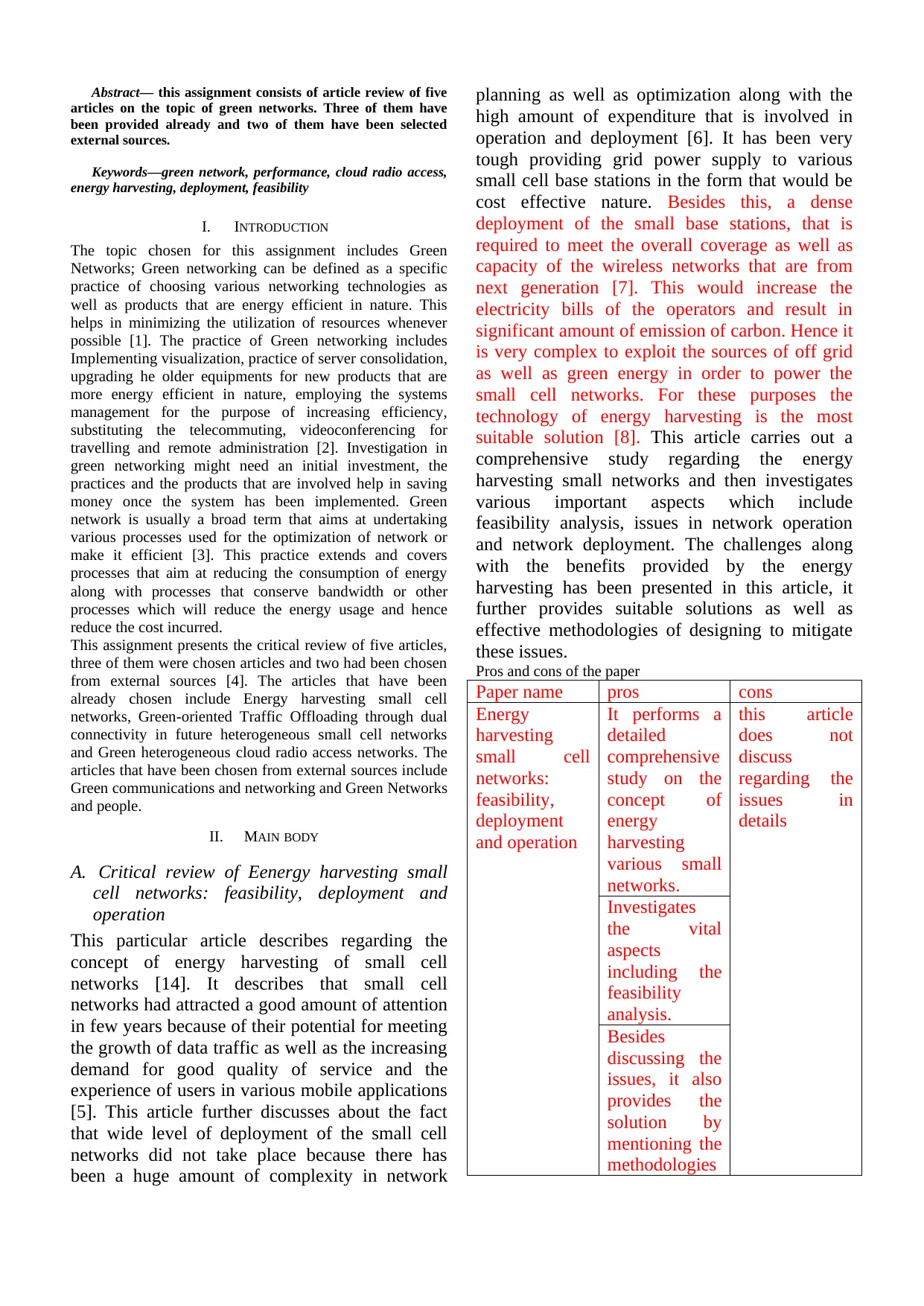
Abstract— this assignment consists of article review of five
articles on the topic of green networks. Three of them have
been provided already and two of them have been selected
external sources.
Keywords—green network, performance, cloud radio access,
energy harvesting, deployment, feasibility
I. INTRODUCTION
The topic chosen for this assignment includes Green
Networks; Green networking can be defined as a specific
practice of choosing various networking technologies as
well as products that are energy efficient in nature. This
helps in minimizing the utilization of resources whenever
possible [1]. The practice of Green networking includes
Implementing visualization, practice of server consolidation,
upgrading he older equipments for new products that are
more energy efficient in nature, employing the systems
management for the purpose of increasing efficiency,
substituting the telecommuting, videoconferencing for
travelling and remote administration [2]. Investigation in
green networking might need an initial investment, the
practices and the products that are involved help in saving
money once the system has been implemented. Green
network is usually a broad term that aims at undertaking
various processes used for the optimization of network or
make it efficient [3]. This practice extends and covers
processes that aim at reducing the consumption of energy
along with processes that conserve bandwidth or other
processes which will reduce the energy usage and hence
reduce the cost incurred.
This assignment presents the critical review of five articles,
three of them were chosen articles and two had been chosen
from external sources [4]. The articles that have been
already chosen include Energy harvesting small cell
networks, Green-oriented Traffic Offloading through dual
connectivity in future heterogeneous small cell networks
and Green heterogeneous cloud radio access networks. The
articles that have been chosen from external sources include
Green communications and networking and Green Networks
and people.
II. MAIN BODY
A. Critical review of Eenergy harvesting small
cell networks: feasibility, deployment and
operation
This particular article describes regarding the
concept of energy harvesting of small cell
networks [14]. It describes that small cell
networks had attracted a good amount of attention
in few years because of their potential for meeting
the growth of data traffic as well as the increasing
demand for good quality of service and the
experience of users in various mobile applications
[5]. This article further discusses about the fact
that wide level of deployment of the small cell
networks did not take place because there has
been a huge amount of complexity in network
planning as well as optimization along with the
high amount of expenditure that is involved in
operation and deployment [6]. It has been very
tough providing grid power supply to various
small cell base stations in the form that would be
cost effective nature. Besides this, a dense
deployment of the small base stations, that is
required to meet the overall coverage as well as
capacity of the wireless networks that are from
next generation [7]. This would increase the
electricity bills of the operators and result in
significant amount of emission of carbon. Hence it
is very complex to exploit the sources of off grid
as well as green energy in order to power the
small cell networks. For these purposes the
technology of energy harvesting is the most
suitable solution [8]. This article carries out a
comprehensive study regarding the energy
harvesting small networks and then investigates
various important aspects which include
feasibility analysis, issues in network operation
and network deployment. The challenges along
with the benefits provided by the energy
harvesting has been presented in this article, it
further provides suitable solutions as well as
effective methodologies of designing to mitigate
these issues.
Pros and cons of the paper
Paper name pros cons
Energy
harvesting
small cell
networks:
feasibility,
deployment
and operation
It performs a
detailed
comprehensive
study on the
concept of
energy
harvesting
various small
networks.
this article
does not
discuss
regarding the
issues in
details
Investigates
the vital
aspects
including the
feasibility
analysis.
Besides
discussing the
issues, it also
provides the
solution by
mentioning the
methodologies
articles on the topic of green networks. Three of them have
been provided already and two of them have been selected
external sources.
Keywords—green network, performance, cloud radio access,
energy harvesting, deployment, feasibility
I. INTRODUCTION
The topic chosen for this assignment includes Green
Networks; Green networking can be defined as a specific
practice of choosing various networking technologies as
well as products that are energy efficient in nature. This
helps in minimizing the utilization of resources whenever
possible [1]. The practice of Green networking includes
Implementing visualization, practice of server consolidation,
upgrading he older equipments for new products that are
more energy efficient in nature, employing the systems
management for the purpose of increasing efficiency,
substituting the telecommuting, videoconferencing for
travelling and remote administration [2]. Investigation in
green networking might need an initial investment, the
practices and the products that are involved help in saving
money once the system has been implemented. Green
network is usually a broad term that aims at undertaking
various processes used for the optimization of network or
make it efficient [3]. This practice extends and covers
processes that aim at reducing the consumption of energy
along with processes that conserve bandwidth or other
processes which will reduce the energy usage and hence
reduce the cost incurred.
This assignment presents the critical review of five articles,
three of them were chosen articles and two had been chosen
from external sources [4]. The articles that have been
already chosen include Energy harvesting small cell
networks, Green-oriented Traffic Offloading through dual
connectivity in future heterogeneous small cell networks
and Green heterogeneous cloud radio access networks. The
articles that have been chosen from external sources include
Green communications and networking and Green Networks
and people.
II. MAIN BODY
A. Critical review of Eenergy harvesting small
cell networks: feasibility, deployment and
operation
This particular article describes regarding the
concept of energy harvesting of small cell
networks [14]. It describes that small cell
networks had attracted a good amount of attention
in few years because of their potential for meeting
the growth of data traffic as well as the increasing
demand for good quality of service and the
experience of users in various mobile applications
[5]. This article further discusses about the fact
that wide level of deployment of the small cell
networks did not take place because there has
been a huge amount of complexity in network
planning as well as optimization along with the
high amount of expenditure that is involved in
operation and deployment [6]. It has been very
tough providing grid power supply to various
small cell base stations in the form that would be
cost effective nature. Besides this, a dense
deployment of the small base stations, that is
required to meet the overall coverage as well as
capacity of the wireless networks that are from
next generation [7]. This would increase the
electricity bills of the operators and result in
significant amount of emission of carbon. Hence it
is very complex to exploit the sources of off grid
as well as green energy in order to power the
small cell networks. For these purposes the
technology of energy harvesting is the most
suitable solution [8]. This article carries out a
comprehensive study regarding the energy
harvesting small networks and then investigates
various important aspects which include
feasibility analysis, issues in network operation
and network deployment. The challenges along
with the benefits provided by the energy
harvesting has been presented in this article, it
further provides suitable solutions as well as
effective methodologies of designing to mitigate
these issues.
Pros and cons of the paper
Paper name pros cons
Energy
harvesting
small cell
networks:
feasibility,
deployment
and operation
It performs a
detailed
comprehensive
study on the
concept of
energy
harvesting
various small
networks.
this article
does not
discuss
regarding the
issues in
details
Investigates
the vital
aspects
including the
feasibility
analysis.
Besides
discussing the
issues, it also
provides the
solution by
mentioning the
methodologies
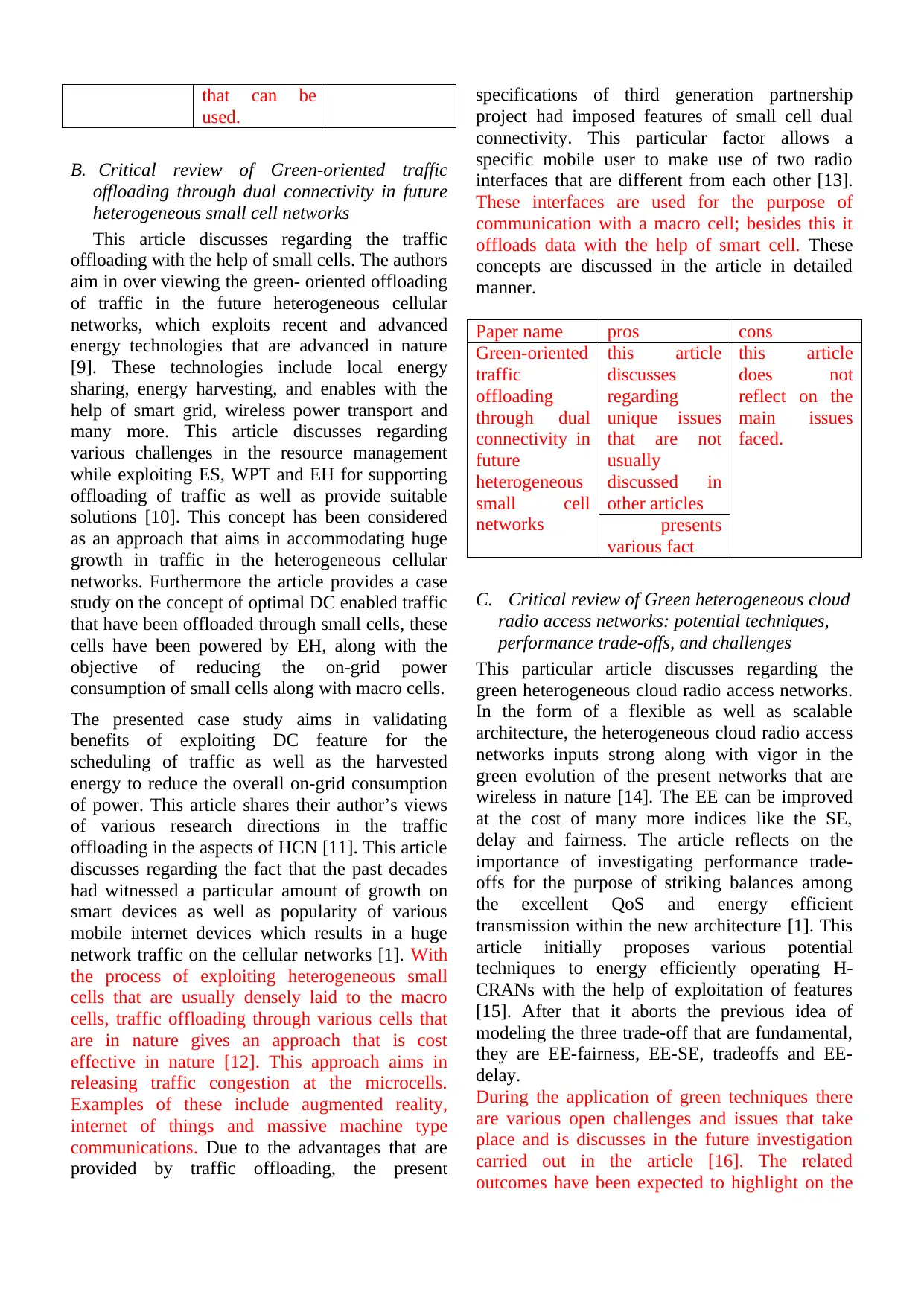
that can be
used.
B. Critical review of Green-oriented traffic
offloading through dual connectivity in future
heterogeneous small cell networks
This article discusses regarding the traffic
offloading with the help of small cells. The authors
aim in over viewing the green- oriented offloading
of traffic in the future heterogeneous cellular
networks, which exploits recent and advanced
energy technologies that are advanced in nature
[9]. These technologies include local energy
sharing, energy harvesting, and enables with the
help of smart grid, wireless power transport and
many more. This article discusses regarding
various challenges in the resource management
while exploiting ES, WPT and EH for supporting
offloading of traffic as well as provide suitable
solutions [10]. This concept has been considered
as an approach that aims in accommodating huge
growth in traffic in the heterogeneous cellular
networks. Furthermore the article provides a case
study on the concept of optimal DC enabled traffic
that have been offloaded through small cells, these
cells have been powered by EH, along with the
objective of reducing the on-grid power
consumption of small cells along with macro cells.
The presented case study aims in validating
benefits of exploiting DC feature for the
scheduling of traffic as well as the harvested
energy to reduce the overall on-grid consumption
of power. This article shares their author’s views
of various research directions in the traffic
offloading in the aspects of HCN [11]. This article
discusses regarding the fact that the past decades
had witnessed a particular amount of growth on
smart devices as well as popularity of various
mobile internet devices which results in a huge
network traffic on the cellular networks [1]. With
the process of exploiting heterogeneous small
cells that are usually densely laid to the macro
cells, traffic offloading through various cells that
are in nature gives an approach that is cost
effective in nature [12]. This approach aims in
releasing traffic congestion at the microcells.
Examples of these include augmented reality,
internet of things and massive machine type
communications. Due to the advantages that are
provided by traffic offloading, the present
specifications of third generation partnership
project had imposed features of small cell dual
connectivity. This particular factor allows a
specific mobile user to make use of two radio
interfaces that are different from each other [13].
These interfaces are used for the purpose of
communication with a macro cell; besides this it
offloads data with the help of smart cell. These
concepts are discussed in the article in detailed
manner.
Paper name pros cons
Green-oriented
traffic
offloading
through dual
connectivity in
future
heterogeneous
small cell
networks
this article
discusses
regarding
unique issues
that are not
usually
discussed in
other articles
this article
does not
reflect on the
main issues
faced.
presents
various fact
C. Critical review of Green heterogeneous cloud
radio access networks: potential techniques,
performance trade-offs, and challenges
This particular article discusses regarding the
green heterogeneous cloud radio access networks.
In the form of a flexible as well as scalable
architecture, the heterogeneous cloud radio access
networks inputs strong along with vigor in the
green evolution of the present networks that are
wireless in nature [14]. The EE can be improved
at the cost of many more indices like the SE,
delay and fairness. The article reflects on the
importance of investigating performance trade-
offs for the purpose of striking balances among
the excellent QoS and energy efficient
transmission within the new architecture [1]. This
article initially proposes various potential
techniques to energy efficiently operating H-
CRANs with the help of exploitation of features
[15]. After that it aborts the previous idea of
modeling the three trade-off that are fundamental,
they are EE-fairness, EE-SE, tradeoffs and EE-
delay.
During the application of green techniques there
are various open challenges and issues that take
place and is discusses in the future investigation
carried out in the article [16]. The related
outcomes have been expected to highlight on the
used.
B. Critical review of Green-oriented traffic
offloading through dual connectivity in future
heterogeneous small cell networks
This article discusses regarding the traffic
offloading with the help of small cells. The authors
aim in over viewing the green- oriented offloading
of traffic in the future heterogeneous cellular
networks, which exploits recent and advanced
energy technologies that are advanced in nature
[9]. These technologies include local energy
sharing, energy harvesting, and enables with the
help of smart grid, wireless power transport and
many more. This article discusses regarding
various challenges in the resource management
while exploiting ES, WPT and EH for supporting
offloading of traffic as well as provide suitable
solutions [10]. This concept has been considered
as an approach that aims in accommodating huge
growth in traffic in the heterogeneous cellular
networks. Furthermore the article provides a case
study on the concept of optimal DC enabled traffic
that have been offloaded through small cells, these
cells have been powered by EH, along with the
objective of reducing the on-grid power
consumption of small cells along with macro cells.
The presented case study aims in validating
benefits of exploiting DC feature for the
scheduling of traffic as well as the harvested
energy to reduce the overall on-grid consumption
of power. This article shares their author’s views
of various research directions in the traffic
offloading in the aspects of HCN [11]. This article
discusses regarding the fact that the past decades
had witnessed a particular amount of growth on
smart devices as well as popularity of various
mobile internet devices which results in a huge
network traffic on the cellular networks [1]. With
the process of exploiting heterogeneous small
cells that are usually densely laid to the macro
cells, traffic offloading through various cells that
are in nature gives an approach that is cost
effective in nature [12]. This approach aims in
releasing traffic congestion at the microcells.
Examples of these include augmented reality,
internet of things and massive machine type
communications. Due to the advantages that are
provided by traffic offloading, the present
specifications of third generation partnership
project had imposed features of small cell dual
connectivity. This particular factor allows a
specific mobile user to make use of two radio
interfaces that are different from each other [13].
These interfaces are used for the purpose of
communication with a macro cell; besides this it
offloads data with the help of smart cell. These
concepts are discussed in the article in detailed
manner.
Paper name pros cons
Green-oriented
traffic
offloading
through dual
connectivity in
future
heterogeneous
small cell
networks
this article
discusses
regarding
unique issues
that are not
usually
discussed in
other articles
this article
does not
reflect on the
main issues
faced.
presents
various fact
C. Critical review of Green heterogeneous cloud
radio access networks: potential techniques,
performance trade-offs, and challenges
This particular article discusses regarding the
green heterogeneous cloud radio access networks.
In the form of a flexible as well as scalable
architecture, the heterogeneous cloud radio access
networks inputs strong along with vigor in the
green evolution of the present networks that are
wireless in nature [14]. The EE can be improved
at the cost of many more indices like the SE,
delay and fairness. The article reflects on the
importance of investigating performance trade-
offs for the purpose of striking balances among
the excellent QoS and energy efficient
transmission within the new architecture [1]. This
article initially proposes various potential
techniques to energy efficiently operating H-
CRANs with the help of exploitation of features
[15]. After that it aborts the previous idea of
modeling the three trade-off that are fundamental,
they are EE-fairness, EE-SE, tradeoffs and EE-
delay.
During the application of green techniques there
are various open challenges and issues that take
place and is discusses in the future investigation
carried out in the article [16]. The related
outcomes have been expected to highlight on the
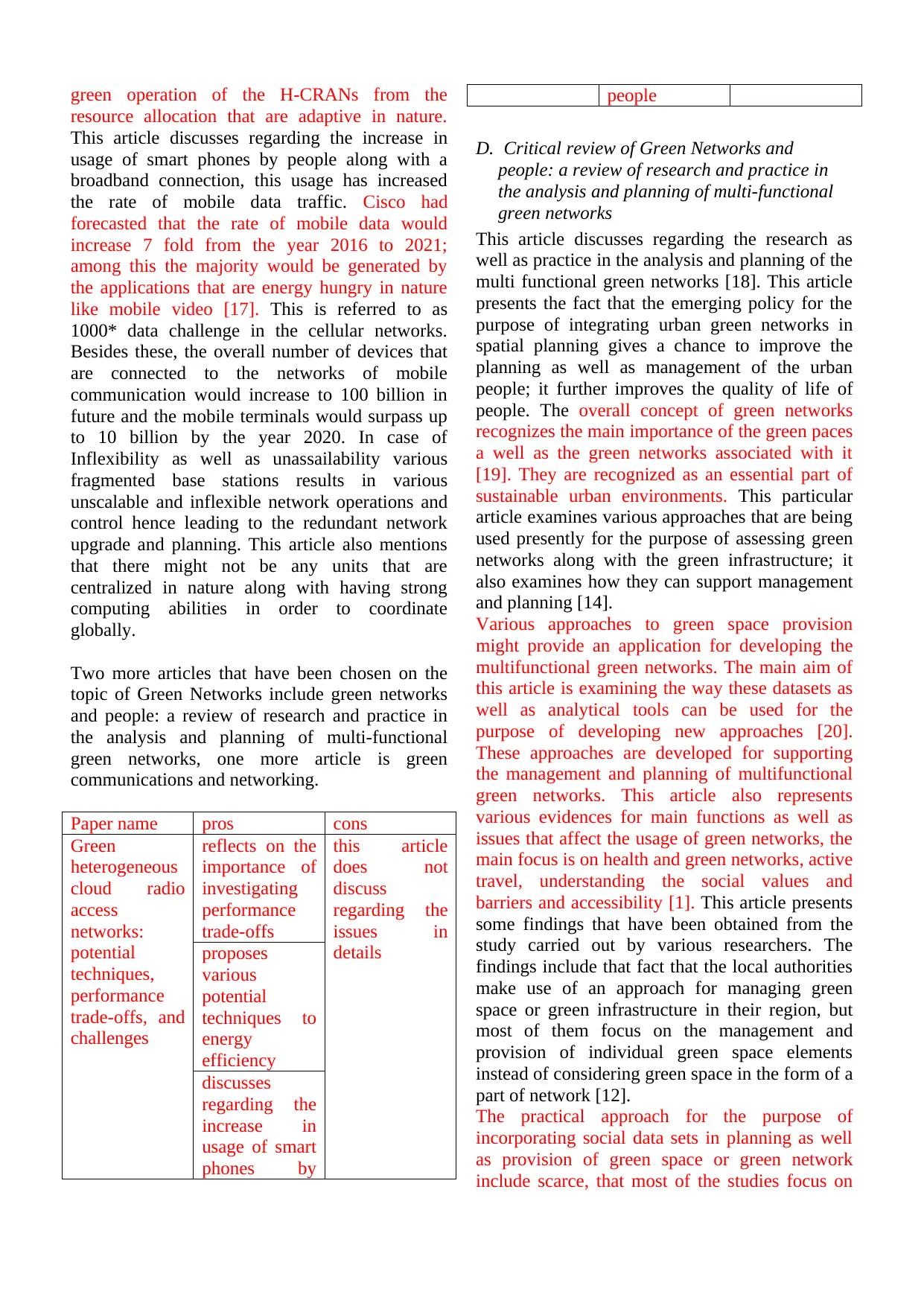
green operation of the H-CRANs from the
resource allocation that are adaptive in nature.
This article discusses regarding the increase in
usage of smart phones by people along with a
broadband connection, this usage has increased
the rate of mobile data traffic. Cisco had
forecasted that the rate of mobile data would
increase 7 fold from the year 2016 to 2021;
among this the majority would be generated by
the applications that are energy hungry in nature
like mobile video [17]. This is referred to as
1000* data challenge in the cellular networks.
Besides these, the overall number of devices that
are connected to the networks of mobile
communication would increase to 100 billion in
future and the mobile terminals would surpass up
to 10 billion by the year 2020. In case of
Inflexibility as well as unassailability various
fragmented base stations results in various
unscalable and inflexible network operations and
control hence leading to the redundant network
upgrade and planning. This article also mentions
that there might not be any units that are
centralized in nature along with having strong
computing abilities in order to coordinate
globally.
Two more articles that have been chosen on the
topic of Green Networks include green networks
and people: a review of research and practice in
the analysis and planning of multi-functional
green networks, one more article is green
communications and networking.
Paper name pros cons
Green
heterogeneous
cloud radio
access
networks:
potential
techniques,
performance
trade-offs, and
challenges
reflects on the
importance of
investigating
performance
trade-offs
this article
does not
discuss
regarding the
issues in
detailsproposes
various
potential
techniques to
energy
efficiency
discusses
regarding the
increase in
usage of smart
phones by
people
D. Critical review of Green Networks and
people: a review of research and practice in
the analysis and planning of multi-functional
green networks
This article discusses regarding the research as
well as practice in the analysis and planning of the
multi functional green networks [18]. This article
presents the fact that the emerging policy for the
purpose of integrating urban green networks in
spatial planning gives a chance to improve the
planning as well as management of the urban
people; it further improves the quality of life of
people. The overall concept of green networks
recognizes the main importance of the green paces
a well as the green networks associated with it
[19]. They are recognized as an essential part of
sustainable urban environments. This particular
article examines various approaches that are being
used presently for the purpose of assessing green
networks along with the green infrastructure; it
also examines how they can support management
and planning [14].
Various approaches to green space provision
might provide an application for developing the
multifunctional green networks. The main aim of
this article is examining the way these datasets as
well as analytical tools can be used for the
purpose of developing new approaches [20].
These approaches are developed for supporting
the management and planning of multifunctional
green networks. This article also represents
various evidences for main functions as well as
issues that affect the usage of green networks, the
main focus is on health and green networks, active
travel, understanding the social values and
barriers and accessibility [1]. This article presents
some findings that have been obtained from the
study carried out by various researchers. The
findings include that fact that the local authorities
make use of an approach for managing green
space or green infrastructure in their region, but
most of them focus on the management and
provision of individual green space elements
instead of considering green space in the form of a
part of network [12].
The practical approach for the purpose of
incorporating social data sets in planning as well
as provision of green space or green network
include scarce, that most of the studies focus on
resource allocation that are adaptive in nature.
This article discusses regarding the increase in
usage of smart phones by people along with a
broadband connection, this usage has increased
the rate of mobile data traffic. Cisco had
forecasted that the rate of mobile data would
increase 7 fold from the year 2016 to 2021;
among this the majority would be generated by
the applications that are energy hungry in nature
like mobile video [17]. This is referred to as
1000* data challenge in the cellular networks.
Besides these, the overall number of devices that
are connected to the networks of mobile
communication would increase to 100 billion in
future and the mobile terminals would surpass up
to 10 billion by the year 2020. In case of
Inflexibility as well as unassailability various
fragmented base stations results in various
unscalable and inflexible network operations and
control hence leading to the redundant network
upgrade and planning. This article also mentions
that there might not be any units that are
centralized in nature along with having strong
computing abilities in order to coordinate
globally.
Two more articles that have been chosen on the
topic of Green Networks include green networks
and people: a review of research and practice in
the analysis and planning of multi-functional
green networks, one more article is green
communications and networking.
Paper name pros cons
Green
heterogeneous
cloud radio
access
networks:
potential
techniques,
performance
trade-offs, and
challenges
reflects on the
importance of
investigating
performance
trade-offs
this article
does not
discuss
regarding the
issues in
detailsproposes
various
potential
techniques to
energy
efficiency
discusses
regarding the
increase in
usage of smart
phones by
people
D. Critical review of Green Networks and
people: a review of research and practice in
the analysis and planning of multi-functional
green networks
This article discusses regarding the research as
well as practice in the analysis and planning of the
multi functional green networks [18]. This article
presents the fact that the emerging policy for the
purpose of integrating urban green networks in
spatial planning gives a chance to improve the
planning as well as management of the urban
people; it further improves the quality of life of
people. The overall concept of green networks
recognizes the main importance of the green paces
a well as the green networks associated with it
[19]. They are recognized as an essential part of
sustainable urban environments. This particular
article examines various approaches that are being
used presently for the purpose of assessing green
networks along with the green infrastructure; it
also examines how they can support management
and planning [14].
Various approaches to green space provision
might provide an application for developing the
multifunctional green networks. The main aim of
this article is examining the way these datasets as
well as analytical tools can be used for the
purpose of developing new approaches [20].
These approaches are developed for supporting
the management and planning of multifunctional
green networks. This article also represents
various evidences for main functions as well as
issues that affect the usage of green networks, the
main focus is on health and green networks, active
travel, understanding the social values and
barriers and accessibility [1]. This article presents
some findings that have been obtained from the
study carried out by various researchers. The
findings include that fact that the local authorities
make use of an approach for managing green
space or green infrastructure in their region, but
most of them focus on the management and
provision of individual green space elements
instead of considering green space in the form of a
part of network [12].
The practical approach for the purpose of
incorporating social data sets in planning as well
as provision of green space or green network
include scarce, that most of the studies focus on
Secure Best Marks with AI Grader
Need help grading? Try our AI Grader for instant feedback on your assignments.
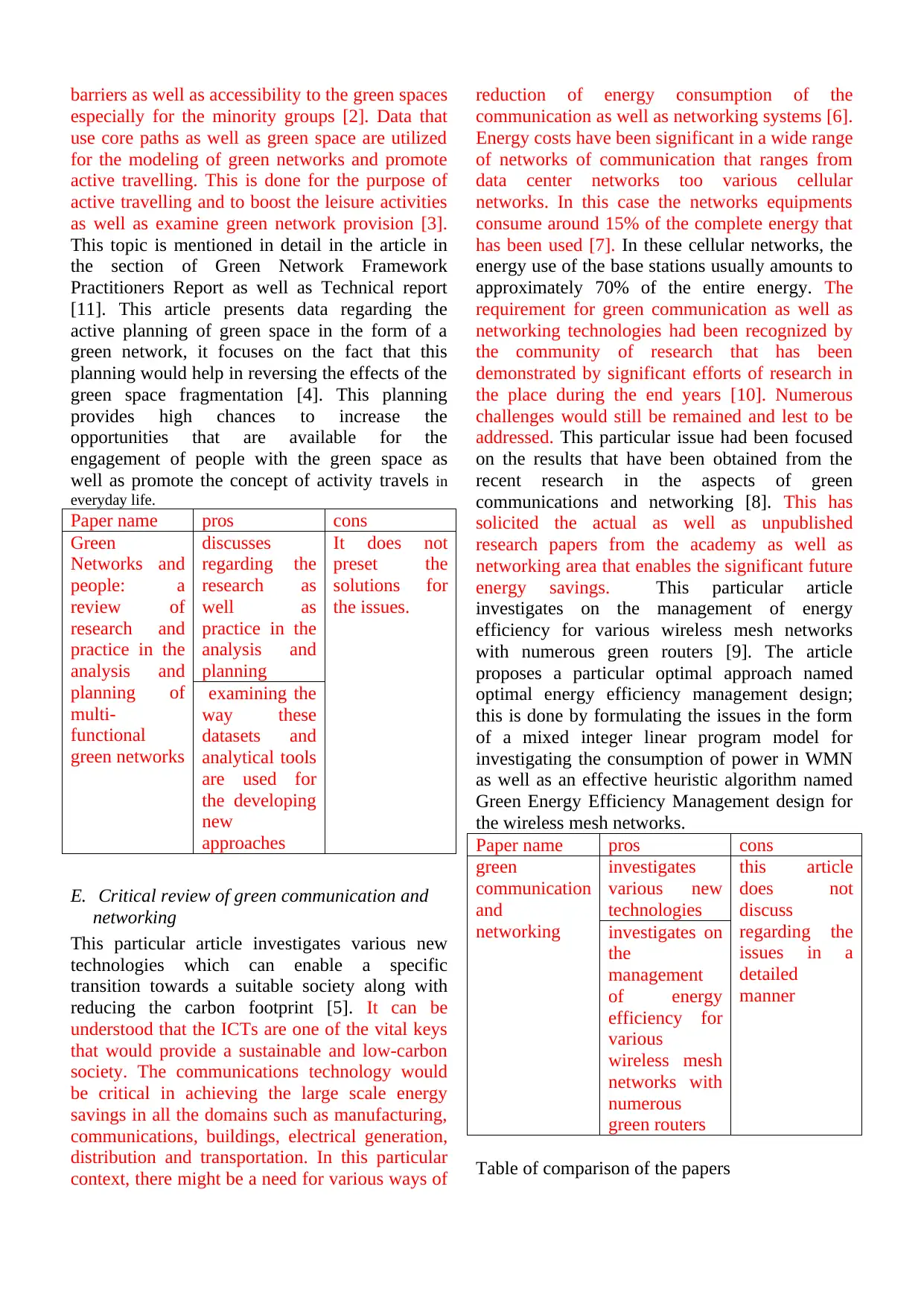
barriers as well as accessibility to the green spaces
especially for the minority groups [2]. Data that
use core paths as well as green space are utilized
for the modeling of green networks and promote
active travelling. This is done for the purpose of
active travelling and to boost the leisure activities
as well as examine green network provision [3].
This topic is mentioned in detail in the article in
the section of Green Network Framework
Practitioners Report as well as Technical report
[11]. This article presents data regarding the
active planning of green space in the form of a
green network, it focuses on the fact that this
planning would help in reversing the effects of the
green space fragmentation [4]. This planning
provides high chances to increase the
opportunities that are available for the
engagement of people with the green space as
well as promote the concept of activity travels in
everyday life.
Paper name pros cons
Green
Networks and
people: a
review of
research and
practice in the
analysis and
planning of
multi-
functional
green networks
discusses
regarding the
research as
well as
practice in the
analysis and
planning
It does not
preset the
solutions for
the issues.
examining the
way these
datasets and
analytical tools
are used for
the developing
new
approaches
E. Critical review of green communication and
networking
This particular article investigates various new
technologies which can enable a specific
transition towards a suitable society along with
reducing the carbon footprint [5]. It can be
understood that the ICTs are one of the vital keys
that would provide a sustainable and low-carbon
society. The communications technology would
be critical in achieving the large scale energy
savings in all the domains such as manufacturing,
communications, buildings, electrical generation,
distribution and transportation. In this particular
context, there might be a need for various ways of
reduction of energy consumption of the
communication as well as networking systems [6].
Energy costs have been significant in a wide range
of networks of communication that ranges from
data center networks too various cellular
networks. In this case the networks equipments
consume around 15% of the complete energy that
has been used [7]. In these cellular networks, the
energy use of the base stations usually amounts to
approximately 70% of the entire energy. The
requirement for green communication as well as
networking technologies had been recognized by
the community of research that has been
demonstrated by significant efforts of research in
the place during the end years [10]. Numerous
challenges would still be remained and lest to be
addressed. This particular issue had been focused
on the results that have been obtained from the
recent research in the aspects of green
communications and networking [8]. This has
solicited the actual as well as unpublished
research papers from the academy as well as
networking area that enables the significant future
energy savings. This particular article
investigates on the management of energy
efficiency for various wireless mesh networks
with numerous green routers [9]. The article
proposes a particular optimal approach named
optimal energy efficiency management design;
this is done by formulating the issues in the form
of a mixed integer linear program model for
investigating the consumption of power in WMN
as well as an effective heuristic algorithm named
Green Energy Efficiency Management design for
the wireless mesh networks.
Paper name pros cons
green
communication
and
networking
investigates
various new
technologies
this article
does not
discuss
regarding the
issues in a
detailed
manner
investigates on
the
management
of energy
efficiency for
various
wireless mesh
networks with
numerous
green routers
Table of comparison of the papers
especially for the minority groups [2]. Data that
use core paths as well as green space are utilized
for the modeling of green networks and promote
active travelling. This is done for the purpose of
active travelling and to boost the leisure activities
as well as examine green network provision [3].
This topic is mentioned in detail in the article in
the section of Green Network Framework
Practitioners Report as well as Technical report
[11]. This article presents data regarding the
active planning of green space in the form of a
green network, it focuses on the fact that this
planning would help in reversing the effects of the
green space fragmentation [4]. This planning
provides high chances to increase the
opportunities that are available for the
engagement of people with the green space as
well as promote the concept of activity travels in
everyday life.
Paper name pros cons
Green
Networks and
people: a
review of
research and
practice in the
analysis and
planning of
multi-
functional
green networks
discusses
regarding the
research as
well as
practice in the
analysis and
planning
It does not
preset the
solutions for
the issues.
examining the
way these
datasets and
analytical tools
are used for
the developing
new
approaches
E. Critical review of green communication and
networking
This particular article investigates various new
technologies which can enable a specific
transition towards a suitable society along with
reducing the carbon footprint [5]. It can be
understood that the ICTs are one of the vital keys
that would provide a sustainable and low-carbon
society. The communications technology would
be critical in achieving the large scale energy
savings in all the domains such as manufacturing,
communications, buildings, electrical generation,
distribution and transportation. In this particular
context, there might be a need for various ways of
reduction of energy consumption of the
communication as well as networking systems [6].
Energy costs have been significant in a wide range
of networks of communication that ranges from
data center networks too various cellular
networks. In this case the networks equipments
consume around 15% of the complete energy that
has been used [7]. In these cellular networks, the
energy use of the base stations usually amounts to
approximately 70% of the entire energy. The
requirement for green communication as well as
networking technologies had been recognized by
the community of research that has been
demonstrated by significant efforts of research in
the place during the end years [10]. Numerous
challenges would still be remained and lest to be
addressed. This particular issue had been focused
on the results that have been obtained from the
recent research in the aspects of green
communications and networking [8]. This has
solicited the actual as well as unpublished
research papers from the academy as well as
networking area that enables the significant future
energy savings. This particular article
investigates on the management of energy
efficiency for various wireless mesh networks
with numerous green routers [9]. The article
proposes a particular optimal approach named
optimal energy efficiency management design;
this is done by formulating the issues in the form
of a mixed integer linear program model for
investigating the consumption of power in WMN
as well as an effective heuristic algorithm named
Green Energy Efficiency Management design for
the wireless mesh networks.
Paper name pros cons
green
communication
and
networking
investigates
various new
technologies
this article
does not
discuss
regarding the
issues in a
detailed
manner
investigates on
the
management
of energy
efficiency for
various
wireless mesh
networks with
numerous
green routers
Table of comparison of the papers
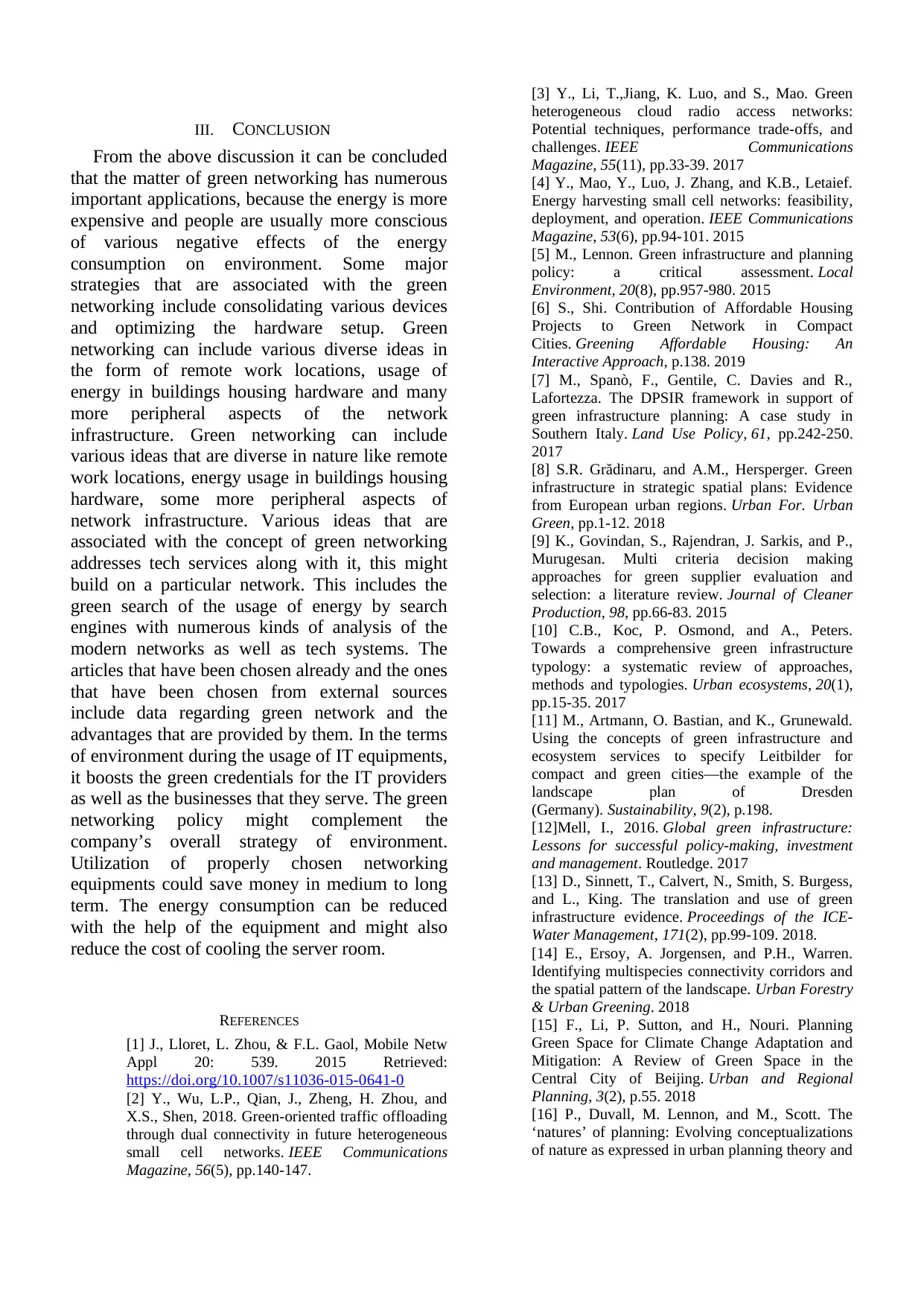
III. CONCLUSION
From the above discussion it can be concluded
that the matter of green networking has numerous
important applications, because the energy is more
expensive and people are usually more conscious
of various negative effects of the energy
consumption on environment. Some major
strategies that are associated with the green
networking include consolidating various devices
and optimizing the hardware setup. Green
networking can include various diverse ideas in
the form of remote work locations, usage of
energy in buildings housing hardware and many
more peripheral aspects of the network
infrastructure. Green networking can include
various ideas that are diverse in nature like remote
work locations, energy usage in buildings housing
hardware, some more peripheral aspects of
network infrastructure. Various ideas that are
associated with the concept of green networking
addresses tech services along with it, this might
build on a particular network. This includes the
green search of the usage of energy by search
engines with numerous kinds of analysis of the
modern networks as well as tech systems. The
articles that have been chosen already and the ones
that have been chosen from external sources
include data regarding green network and the
advantages that are provided by them. In the terms
of environment during the usage of IT equipments,
it boosts the green credentials for the IT providers
as well as the businesses that they serve. The green
networking policy might complement the
company’s overall strategy of environment.
Utilization of properly chosen networking
equipments could save money in medium to long
term. The energy consumption can be reduced
with the help of the equipment and might also
reduce the cost of cooling the server room.
REFERENCES
[1] J., Lloret, L. Zhou, & F.L. Gaol, Mobile Netw
Appl 20: 539. 2015 Retrieved:
https://doi.org/10.1007/s11036-015-0641-0
[2] Y., Wu, L.P., Qian, J., Zheng, H. Zhou, and
X.S., Shen, 2018. Green-oriented traffic offloading
through dual connectivity in future heterogeneous
small cell networks. IEEE Communications
Magazine, 56(5), pp.140-147.
[3] Y., Li, T.,Jiang, K. Luo, and S., Mao. Green
heterogeneous cloud radio access networks:
Potential techniques, performance trade-offs, and
challenges. IEEE Communications
Magazine, 55(11), pp.33-39. 2017
[4] Y., Mao, Y., Luo, J. Zhang, and K.B., Letaief.
Energy harvesting small cell networks: feasibility,
deployment, and operation. IEEE Communications
Magazine, 53(6), pp.94-101. 2015
[5] M., Lennon. Green infrastructure and planning
policy: a critical assessment. Local
Environment, 20(8), pp.957-980. 2015
[6] S., Shi. Contribution of Affordable Housing
Projects to Green Network in Compact
Cities. Greening Affordable Housing: An
Interactive Approach, p.138. 2019
[7] M., Spanò, F., Gentile, C. Davies and R.,
Lafortezza. The DPSIR framework in support of
green infrastructure planning: A case study in
Southern Italy. Land Use Policy, 61, pp.242-250.
2017
[8] S.R. Grădinaru, and A.M., Hersperger. Green
infrastructure in strategic spatial plans: Evidence
from European urban regions. Urban For. Urban
Green, pp.1-12. 2018
[9] K., Govindan, S., Rajendran, J. Sarkis, and P.,
Murugesan. Multi criteria decision making
approaches for green supplier evaluation and
selection: a literature review. Journal of Cleaner
Production, 98, pp.66-83. 2015
[10] C.B., Koc, P. Osmond, and A., Peters.
Towards a comprehensive green infrastructure
typology: a systematic review of approaches,
methods and typologies. Urban ecosystems, 20(1),
pp.15-35. 2017
[11] M., Artmann, O. Bastian, and K., Grunewald.
Using the concepts of green infrastructure and
ecosystem services to specify Leitbilder for
compact and green cities—the example of the
landscape plan of Dresden
(Germany). Sustainability, 9(2), p.198.
[12]Mell, I., 2016. Global green infrastructure:
Lessons for successful policy-making, investment
and management. Routledge. 2017
[13] D., Sinnett, T., Calvert, N., Smith, S. Burgess,
and L., King. The translation and use of green
infrastructure evidence. Proceedings of the ICE-
Water Management, 171(2), pp.99-109. 2018.
[14] E., Ersoy, A. Jorgensen, and P.H., Warren.
Identifying multispecies connectivity corridors and
the spatial pattern of the landscape. Urban Forestry
& Urban Greening. 2018
[15] F., Li, P. Sutton, and H., Nouri. Planning
Green Space for Climate Change Adaptation and
Mitigation: A Review of Green Space in the
Central City of Beijing. Urban and Regional
Planning, 3(2), p.55. 2018
[16] P., Duvall, M. Lennon, and M., Scott. The
‘natures’ of planning: Evolving conceptualizations
of nature as expressed in urban planning theory and
From the above discussion it can be concluded
that the matter of green networking has numerous
important applications, because the energy is more
expensive and people are usually more conscious
of various negative effects of the energy
consumption on environment. Some major
strategies that are associated with the green
networking include consolidating various devices
and optimizing the hardware setup. Green
networking can include various diverse ideas in
the form of remote work locations, usage of
energy in buildings housing hardware and many
more peripheral aspects of the network
infrastructure. Green networking can include
various ideas that are diverse in nature like remote
work locations, energy usage in buildings housing
hardware, some more peripheral aspects of
network infrastructure. Various ideas that are
associated with the concept of green networking
addresses tech services along with it, this might
build on a particular network. This includes the
green search of the usage of energy by search
engines with numerous kinds of analysis of the
modern networks as well as tech systems. The
articles that have been chosen already and the ones
that have been chosen from external sources
include data regarding green network and the
advantages that are provided by them. In the terms
of environment during the usage of IT equipments,
it boosts the green credentials for the IT providers
as well as the businesses that they serve. The green
networking policy might complement the
company’s overall strategy of environment.
Utilization of properly chosen networking
equipments could save money in medium to long
term. The energy consumption can be reduced
with the help of the equipment and might also
reduce the cost of cooling the server room.
REFERENCES
[1] J., Lloret, L. Zhou, & F.L. Gaol, Mobile Netw
Appl 20: 539. 2015 Retrieved:
https://doi.org/10.1007/s11036-015-0641-0
[2] Y., Wu, L.P., Qian, J., Zheng, H. Zhou, and
X.S., Shen, 2018. Green-oriented traffic offloading
through dual connectivity in future heterogeneous
small cell networks. IEEE Communications
Magazine, 56(5), pp.140-147.
[3] Y., Li, T.,Jiang, K. Luo, and S., Mao. Green
heterogeneous cloud radio access networks:
Potential techniques, performance trade-offs, and
challenges. IEEE Communications
Magazine, 55(11), pp.33-39. 2017
[4] Y., Mao, Y., Luo, J. Zhang, and K.B., Letaief.
Energy harvesting small cell networks: feasibility,
deployment, and operation. IEEE Communications
Magazine, 53(6), pp.94-101. 2015
[5] M., Lennon. Green infrastructure and planning
policy: a critical assessment. Local
Environment, 20(8), pp.957-980. 2015
[6] S., Shi. Contribution of Affordable Housing
Projects to Green Network in Compact
Cities. Greening Affordable Housing: An
Interactive Approach, p.138. 2019
[7] M., Spanò, F., Gentile, C. Davies and R.,
Lafortezza. The DPSIR framework in support of
green infrastructure planning: A case study in
Southern Italy. Land Use Policy, 61, pp.242-250.
2017
[8] S.R. Grădinaru, and A.M., Hersperger. Green
infrastructure in strategic spatial plans: Evidence
from European urban regions. Urban For. Urban
Green, pp.1-12. 2018
[9] K., Govindan, S., Rajendran, J. Sarkis, and P.,
Murugesan. Multi criteria decision making
approaches for green supplier evaluation and
selection: a literature review. Journal of Cleaner
Production, 98, pp.66-83. 2015
[10] C.B., Koc, P. Osmond, and A., Peters.
Towards a comprehensive green infrastructure
typology: a systematic review of approaches,
methods and typologies. Urban ecosystems, 20(1),
pp.15-35. 2017
[11] M., Artmann, O. Bastian, and K., Grunewald.
Using the concepts of green infrastructure and
ecosystem services to specify Leitbilder for
compact and green cities—the example of the
landscape plan of Dresden
(Germany). Sustainability, 9(2), p.198.
[12]Mell, I., 2016. Global green infrastructure:
Lessons for successful policy-making, investment
and management. Routledge. 2017
[13] D., Sinnett, T., Calvert, N., Smith, S. Burgess,
and L., King. The translation and use of green
infrastructure evidence. Proceedings of the ICE-
Water Management, 171(2), pp.99-109. 2018.
[14] E., Ersoy, A. Jorgensen, and P.H., Warren.
Identifying multispecies connectivity corridors and
the spatial pattern of the landscape. Urban Forestry
& Urban Greening. 2018
[15] F., Li, P. Sutton, and H., Nouri. Planning
Green Space for Climate Change Adaptation and
Mitigation: A Review of Green Space in the
Central City of Beijing. Urban and Regional
Planning, 3(2), p.55. 2018
[16] P., Duvall, M. Lennon, and M., Scott. The
‘natures’ of planning: Evolving conceptualizations
of nature as expressed in urban planning theory and

practice. European Planning Studies, 26(3),
pp.480-501. 2018
[17] G., Pulighe, F. Fava, and F., Lupia. Insights
and opportunities from mapping ecosystem
services of urban green spaces and potentials in
planning. Ecosystem services, 22, pp.1-10. 2016
[18] E., Ersoy, A. Jorgensen, and P.H.,Warren,.
Green and ecological networks in Sheffield,
UK. Landscape Research, pp.1-15. 2018
[19] E. Lähde, and M., Di Marino.
Multidisciplinary collaboration and understanding
of green infrastructure Results from the cities of
Tampere, Vantaa and Jyväskylä (Finland). Urban
Forestry & Urban Greening. 2018
[20] K.L., Fung,. Expanding the Green Network on
Rooftops: A Study of Integrating Green Roofs as a
Part of Urban Green Space Planning (Doctoral
dissertation, Tufts University). 2018
pp.480-501. 2018
[17] G., Pulighe, F. Fava, and F., Lupia. Insights
and opportunities from mapping ecosystem
services of urban green spaces and potentials in
planning. Ecosystem services, 22, pp.1-10. 2016
[18] E., Ersoy, A. Jorgensen, and P.H.,Warren,.
Green and ecological networks in Sheffield,
UK. Landscape Research, pp.1-15. 2018
[19] E. Lähde, and M., Di Marino.
Multidisciplinary collaboration and understanding
of green infrastructure Results from the cities of
Tampere, Vantaa and Jyväskylä (Finland). Urban
Forestry & Urban Greening. 2018
[20] K.L., Fung,. Expanding the Green Network on
Rooftops: A Study of Integrating Green Roofs as a
Part of Urban Green Space Planning (Doctoral
dissertation, Tufts University). 2018
Paraphrase This Document
Need a fresh take? Get an instant paraphrase of this document with our AI Paraphraser

1 out of 8
Your All-in-One AI-Powered Toolkit for Academic Success.
+13062052269
info@desklib.com
Available 24*7 on WhatsApp / Email
![[object Object]](/_next/static/media/star-bottom.7253800d.svg)
Unlock your academic potential
© 2024 | Zucol Services PVT LTD | All rights reserved.
